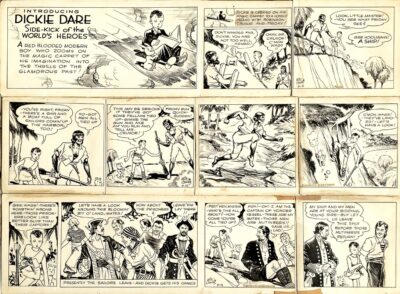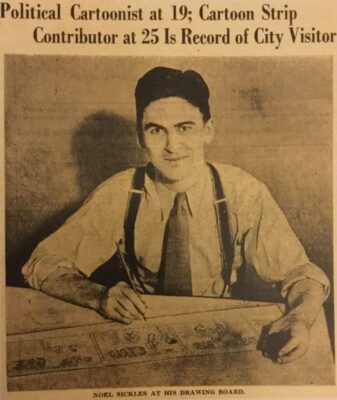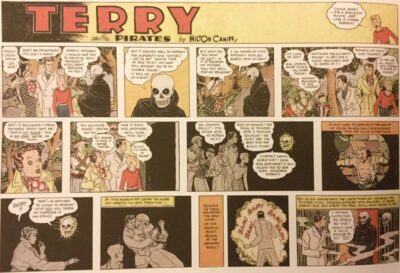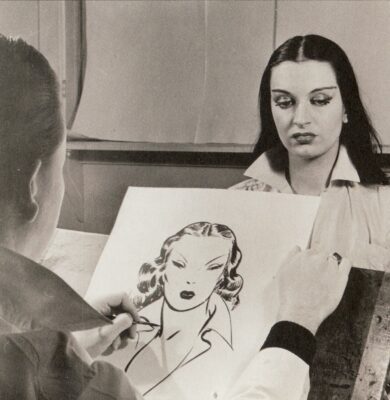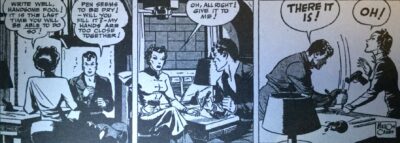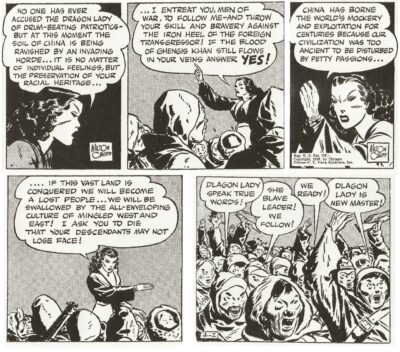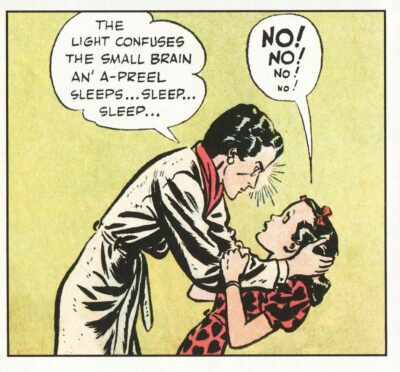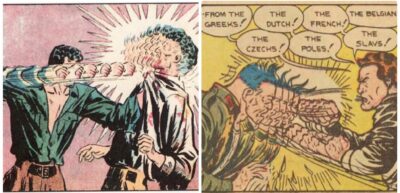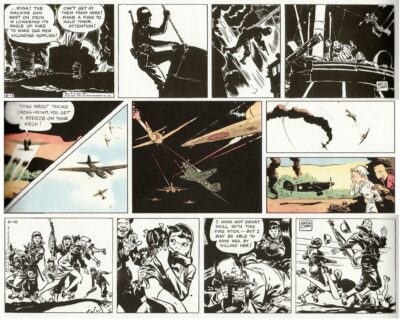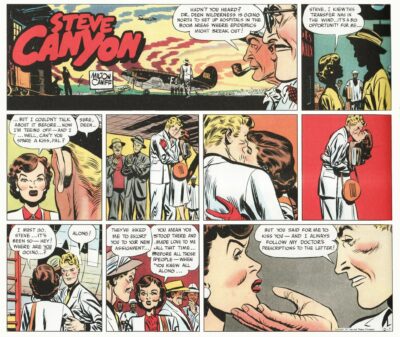Milton Caniff: Key Inspiration of Comic Books by Alex Grand
Read Alex Grand’s Understanding Superhero Comic Books published by McFarland Books in 2023 with Foreword by Jim Steranko with editorial reviews by comic book professionals, Jim Shooter, Tom Palmer, Tom DeFalco, Danny Fingeroth, Alex Segura, Carl Potts, Guy Dorian Sr. and more.
In the meantime enjoy the show:
Milton Caniff, a renowned cartoonist, left a remarkable impact on the comic book world through his unique style of portraying personality traits, social and political issues.
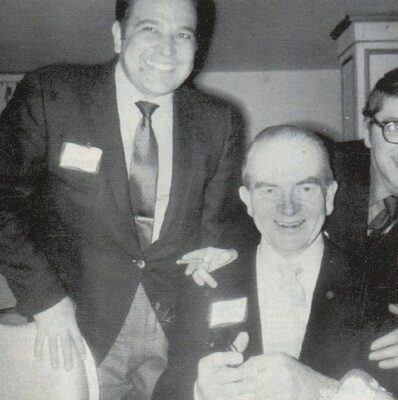
Today we examine 11 key works and techniques that showcase how his comic strip artistry influenced the comic industry.
#1: Dickie Dare
In the summer of 1933, Milton Caniff began working on a comic strip called “Dickie Dare,” which was an adventure fantasy strip that ran until early 1934. Despite the title, the comic was not intended for adults, but rather focused on the character’s dream of having legendary adventures with famous figures such as Robin Hood and King Arthur. Through the strip, Caniff demonstrated his ability to transition from fantasy to reality by gradually shifting Dickie’s experiences from dreams to real-life adventures. This technique helped establish Caniff as a masterful storyteller, and his work on “Dickie Dare” laid the foundation for his later success with other popular comic strips such as “Terry and the Pirates.”
#2: Terry and the Pirates
Milton Caniff, a celebrated comic strip artist, was indeed influenced by his friend Noel Sickles and hired by the New York Daily News to create a new strip for the Chicago Tribune in late 1934. At the time, Caniff knew little about China and its culture, so he researched extensively to create an accurate depiction of Chinese life and history. He discovered that some Chinese families had a history of piracy, which inspired the creation of the strip “Terry and the Pirates.” The strip became one of Caniff’s most successful works, and it is still considered influential to this day. Additionally, “Terry and the Pirates” allowed Caniff to showcase his artistic talents and explore significant political issues.
“Terry and the Pirates” depicts the adventures of a young boy named Terry Lee, who travels with his adult companion, Pat Ryan, to different locations, encountering pirates and other fascinating characters. The comic spanned 12 years, from 1934 to 1946, and followed Terry as he grew up and eventually served in the Army Air Forces during World War II. Along the way, the comic explored various themes and storylines that were both entertaining and insightful.
#3: Dragon Lady
Dragon Lady was a character created by Milton Caniff for the “Terry and the Pirates” comic strip. She was a pirate queen who was portrayed as ruthless and determined to make a name for herself in a patriarchal society. Her character represented various social and political issues, such as gender roles and power dynamics, and was considered groundbreaking at the time for its exploration of these themes.
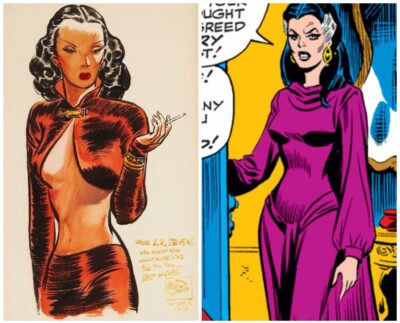
Despite her ruthless persona, Dragon Lady also had a romantic side, as she was depicted as having a yearning for Pat Ryan, one of the main characters in the strip. This portrayal of a complex female character who defied traditional gender roles was significant for its time and helped establish Caniff as a master of character development and storytelling.
Overall, Dragon Lady was a pivotal character in the “Terry and the Pirates” comic strip, and her portrayal demonstrated Caniff’s ability to tackle serious social issues while maintaining femininity.
#4: Pat Ryan
Pat Ryan was the Bruce Wayne of the strip, the parental figure who adopted Terry in the “Terry and the Pirates” comic strip created by Milton Caniff. In one of the scenes from the 1936 comics, Pat Ryan saved his own life by using his knowledge and intellect to outsmart the Dragon Lady, proving that his pen was mightier than her sword.
#5: No Illusion of Change
Milton Caniff, the creator of “Terry and the Pirates,” was known for his innovative approach to character development and storytelling. In the comic strip, Caniff aged Terry Lee in real time over the course of 12 years, from 1934 to 1946. This was considered risky at the time, as it could potentially affect the brand permanence of the comic strip. However, Caniff went ahead with the aging of Terry Lee as he believed it was essential to the character’s growth and development.
![]() Caniff’s ability to show Terry’s growth over 12 years while maintaining the high standard of the strip was a significant achievement that influenced modern comic artists. Caniff’s work on “Terry and the Pirates” demonstrated that aging a comic character could be done successfully and that it could add depth and complexity to the story.
Caniff’s ability to show Terry’s growth over 12 years while maintaining the high standard of the strip was a significant achievement that influenced modern comic artists. Caniff’s work on “Terry and the Pirates” demonstrated that aging a comic character could be done successfully and that it could add depth and complexity to the story.
#6 Rape of Nanking
Milton Caniff, the creator of “Terry and the Pirates,” was known for his ability to incorporate real-world events and political issues into his comic strips. After the 1937 Japanese Rape of Nanking, Caniff created a series of dailies that depicted the Dragon Lady rallying Chinese bandits into a fighting army to resist the invading forces of the second Sino-Japanese war. This storyline was one of many facets of World War II that Caniff explored in his comic strip.
Caniff’s portrayal of the events in China and the resistance movement was significant for its time and helped raise awareness of the conflict in the East among American readers. Caniff’s work on “Terry and the Pirates” was known for its innovative approach to storytelling and its ability to address real-world issues in a compelling and engaging way.
#7: Taboo social issues
Milton Caniff was known for his innovative approach to storytelling, and his willingness to tackle controversial and taboo subjects in his comic strips. In the early 1940s, Caniff introduced a recurring villainous character named Sanjak in “Terry and the Pirates.” While Sanjak was not explicitly portrayed as a LGBTQ character, there were some subtextual hints in the storyline that suggested Sanjak may have had romantic feelings for Terry’s girlfriend, April.
While the portrayal of LGBTQ characters in mainstream media during this time was not openly discussed or portrayed, the subtextual hints in Sanjak’s storyline could be seen as a reflection of Caniff’s willingness to challenge traditional gender roles and stereotypes in his comic strips.
Overall, Caniff’s work did challenge traditional stereotypes and played a role in advancing the representation of diverse voices in the medium of comics.
#8: Demonstration of movement
Milton Caniff was known for his ability to depict movement and action in his comic strip scenes. Caniff was a master of visual storytelling, and he used his knowledge of anatomy and physics to create dynamic and kinetic scenes that were both exciting and engaging.
In particular, Caniff was skilled at depicting fight scenes in his comic strips. He was able to convey the movement and speed of his characters in a way that was both realistic and visually compelling. Caniff’s use of techniques such as motion lines, dynamic angles, and the integration of sound effects helped bring his fight scenes to life and made them some of the most memorable moments in his work.
#9: Demonstration of emotion
Milton Caniff was highly skilled in portraying emotion in his comic strips. One example of this is in the October 1941 storyline of “Terry and the Pirates,” where Caniff depicted the characters Dude Henning and Terry processing the death of Dude’s love interest, Raven Sherman.
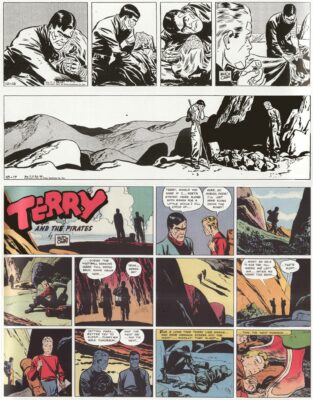 In this storyline, Caniff used a variety of techniques to convey the characters’ grief and emotional turmoil. He used close-up shots to show the characters’ facial expressions and body language, and he integrated thought bubbles and dialogue to convey their inner thoughts and feelings. The result was a poignant and emotionally impactful storyline that resonated with readers at the time.
In this storyline, Caniff used a variety of techniques to convey the characters’ grief and emotional turmoil. He used close-up shots to show the characters’ facial expressions and body language, and he integrated thought bubbles and dialogue to convey their inner thoughts and feelings. The result was a poignant and emotionally impactful storyline that resonated with readers at the time.
#10: WAR
Milton Caniff was skilled in exploring various genres in his comic strip work, including the War genre. During World War II, Caniff used his talents to depict the elegance and uncertainty of air and land battles in his comic strips.
Caniff’s ability to capture the drama and intensity of wartime scenes was exceptional, and his depictions of battles were often described as “cinematic” in their scope and detail. He used techniques such as dynamic angles, dramatic lighting, and careful attention to detail to create scenes that were both visually stunning and emotionally impactful.
#11: Steve Canyon
Milton Caniff is best known for his work on “Terry and the Pirates,” he also created other notable comic strips such as “Steve Canyon.” “Steve Canyon” was an action-adventure comic strip that followed the adventures of a pilot as he tackled various challenges around the world.
One of the notable aspects of “Steve Canyon” was Caniff’s introduction of heroes who faced more realistic and relatable everyday struggles. This was a departure from the larger-than-life heroes that were common in comics at the time, and it helped to establish a new trend in the genre.
Additionally, Caniff used his work on “Steve Canyon” to explore personal relationships and help pioneer what could be seen as the Romance Comic format.
Milton Caniff was a highly skilled and influential cartoonist, whose legacy has had a significant impact on the comic world. Throughout his career, he produced a wide range of notable works, each showcasing his unique talents and contributions to the medium.
From his pioneering work on “Terry and the Pirates,” to his exploration of the War genre and his creation of “Steve Canyon,” Caniff was a visionary artist who pushed the boundaries of comic strip storytelling. His ability to portray emotion, movement, and realistic characters helped to establish new trends in the genre, and his innovative techniques continue to inspire artists and storytellers to this day.
Overall, Caniff’s contributions to the world of comics are immense, and his legacy continues to be celebrated by fans and creators alike. With a vast body of work to enjoy, his impact on the medium is sure to be felt for generations to come.
Join us for more discussion at our Facebook group
check out our CBH documentary videos on our CBH Youtube Channel
get some historic comic book shirts, pillows, etc at CBH Merchandise
check out our CBH Podcast available on Apple Podcasts, Google PlayerFM and Stitcher.
Use of images are not intended to infringe on copyright, but merely used for academic purpose.
Images used ©Their Respective Copyright Holders









